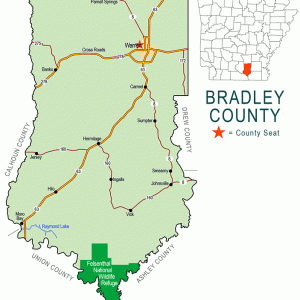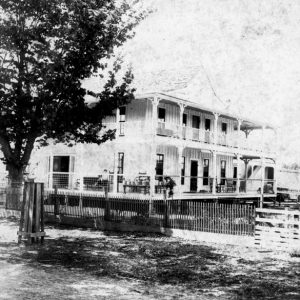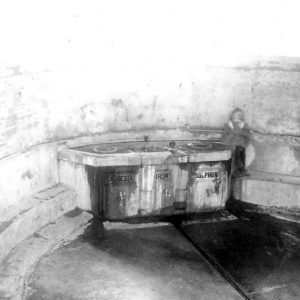calsfoundation@cals.org
Parnell Springs (Bradley County)
Parnell Springs was located ten miles northwest of Warren (Bradley County) and seven miles south of New Edinburg (Cleveland County), two miles off Highway 8 on a gravel road. It was a booming health resort noted for the healing qualities of its three springs, especially between 1880 and the 1920s.
The exact date of the Parnell Springs’ founding in Bradley County is not known, but by 1880, it was both a community and health resort. The community took its name from Joseph M. Parnell, who was the first to capitalize on the water and resort area. In the mid-nineteenth century, many Parnells and their relatives populated the area, including Anna Moseley Parnell, who emigrated from Alabama during the 1840s and was the great-grandmother of future Arkansas governor Harvey Parnell. In 1881, Joseph M. Parnell purchased the land and built a log house, which later became a hotel, and a small store near the property. Parnell also began to sell bottled water from the springs, bottling it in five-gallon containers and shipping it by buggy to Warren. When business increased, he delivered to other locations by train.
Parnell soon found himself overworked with an increasing clientele and so sold his resort to one W. L. Kennedy. In 1893, after adding a large dining room and making other improvements, Kennedy sold the property to Robert Wells, who tore down the original log building, built the Wells Hotel, and added a new Wells Pavilion over the springs between 1893 and 1898. He tried to established a post office at the springs, but these efforts fell through. By the turn of the twentieth century, the resort—with its hotel, cabins, and the pavilion covering the springs—was a popular spot for social and religious events.
Places of interest in Parnell Springs included the Moseley Cemetery, where large groups met for annual reunions from 1840 onward. During the middle to the end of the nineteenth century, the annual Methodist camp meeting was held under a brush arbor, often attracting over 1,000 people. Families came in wagons and cooked on the grounds as the young and old alike bathed in the waters of Parnell Springs, which were thought to have healing properties. The springs were especially fashionable during the hot summer months when cholera was a problem in most local rivers.
By the early 1900s, Parnell Springs was a booming community where the next owner, J. A. Smith, built a water tower holding 8,000 gallons of water from the springs. The community also had cabins for rent, stables for the horses and carriages, a restaurant, a sawmill, two cotton gins, a boarding house, two stores, grist and corn mills, a blacksmith shop, a post office, two schools, and a barbershop. Most of the businesses were in or around the hotel and springs. The financial strain of maintaining his business caused Smith, in 1906, to lose the property to Southern Lumber Company of Warren.
During the hard times of the 1920s and 1930s, interest declined in the health resort, and Parnell Springs was closed. In the twenty-first century, the hotel is gone and the pavilion has collapsed, leaving only the broken springs and concrete steps of what once was a popular resort.
For additional information:
Gatewood, Robert. Parnell Springs. Warren, AR: Bradley County Roots, 1979.
Harrell, Helen Odum. The Heldebrand Heritage. New Braunfels, AR: Nevada County Library Publishers, 1998.
Moseley, Ron. The Life and Times of Parnell Springs. North Little Rock, AR: Mozark Publications, 1999.
Ron Moseley
North Little Rock, Arkansas
 Health and Medicine
Health and Medicine Tourism
Tourism Bradley County Map
Bradley County Map  Parnell Springs Hotel
Parnell Springs Hotel  Parnell Springs Spring
Parnell Springs Spring 



Comments
No comments on this entry yet.